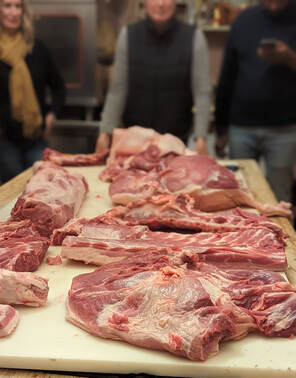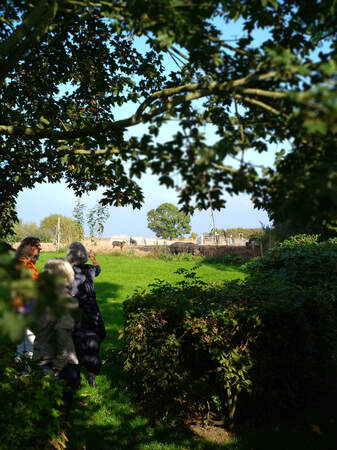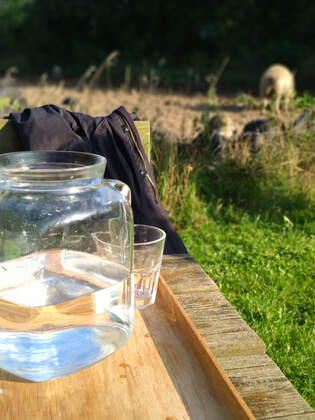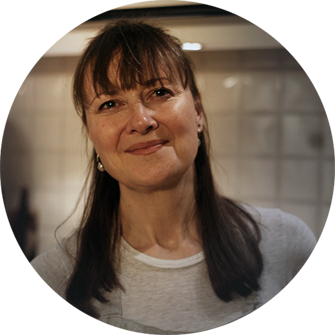The mood is sombre as we gather at the edge of the field, just metres away from the house in which we are staying this week. Perhaps we are a little nervous. The joking and bonhomie have ceased for a while. Poul, our host, has brought a small group of us to witness the profound act that is about to take place. He has everything in order; everything prepared to make what follows quick, painless and stress-free. He throws a handful of meal down for the gathering animals then deftly presses the electric charges either side of the chosen pig, once through the brain, then through the chest. The animal slumps quietly at the first. The other animals keep eating as the pig is then hoisted out of the field and bled, feet away. If they have noticed, they show no sign.
 Pig butchery by Fabio Borgoni Terroir Tuscany 2023 Pig butchery by Fabio Borgoni Terroir Tuscany 2023 Our farm tour over, we change and move inside. We first visit the room where the pig, whose death we have witnessed, is being prepared for veterinary inspection and later, butchering. The government vet is responsible for visiting small abattoirs and the few licenced farmers, like Poul, to inspect both the recent health of the animal and the manner of its death. Most Danish pigs, however, are dealt with at one of two large cooperative abattoirs – a throughput of millions each year. The time and attention we have witnessed so far could not possibly be afforded to all those animals. Denmark is home to about 5000 pig farms and around 3000 of these are super-farms, housing more than 5000 pigs. And yet as I travelled the two hours from Copenhagen to Poul and Carla’s farm, I spotted not a single pig. Coming from the UK, where 40% of the pig population is farmed outdoors, I had expected to see the fields full of sows and piglets, their familiar corrugated shelters dotting the landscape. Here, the pigs are invisible. Their welfare – or lack of it – is a matter for the production unit owners, their workers and the government. The consumer is blissfully, or maybe wilfully, ignorant. 90% of Denmark’s 28 million pigs slaughtered each year are destined for export. Such is the worldwide demand for pork; in many parts of the world, it is customary to eat meat three times a day. And, it has to be said, Denmark’s welfare and food safety standards are very high compared with much of the rest of the world and many of the countries it exports to. Simply stated, to satisfy current demand, it would be impossible to produce pigs as Poul and Carla do, on small scale operations, slaughtering in a painless and stress-free way and without live transportation. And here’s the rub: we need to reduce production. We need to eat less meat. We have to reconnect with the process. We have to see the meat we eat as once a living animal that ought to be respected. It should not be a throw-away, disposable commodity. If we are prepared to eat meat, we must be prepared to understand and engage with the farming practices that have produced that meat. We must be prepared to eat less in order that we can pay more. We must be prepared to value this food for all that it is worth and all that it has come from. The question is how do we effect this change? At first, it seems like an impossibility – changing people’s attitudes to meat-eating and meat production is fraught with economical, historical and cultural sensitivities. But then I am reminded of how far we have come in the UK and Europe with regard to egg production. In January 2012, legislation was brought in to end the battery farming of hens within Europe. A good start but, of course, there’s always wriggle-room in legislation and it didn’t put an end to caged birds altogether. However, consumer pressure in the UK meant that one by one supermarkets were under peer pressure to announce they would only sell free-range eggs. Many chain restaurants were hard on their heels. Because that’s what consumers demanded. Not perfect – plenty of room for improved welfare – but a big change in the last 20 years. However, crucially, this welfare change meant the consumer was faced with only a small premium in the price they paid. High-welfare, small-production meat from regenerative farms would mean a huge increase in cost – maybe more than 100%. The world’s population cannot afford to pay such prices. But they can make choices. Not everyone. Not everywhere. But we can make a start. We can apply consumer pressure and outrage at intensively farmed meat from caged animals. We can connect with the process of meat production and share our knowledge with others. Let no one forget that that sterile, shrunkwrapped polystyrene tray of meat in the supermarket was once a living, breathing animal and that it’s life mattered. We can ensure nothing is wasted – either from the butchered animal or from the meat we buy. No life is disposable. No meat should be thrown away. If we valued it more, we would pay more. But the simpler truth is this: perhaps if we paid more, we would value it more. |
Our workshops are run by award-winning sourdough baker Helen Underwood.
Categories
All
Archives
November 2023
|




